My Experience Trying the Dexcom Stelo Continuous Glucose Monitor (CGM)
December 14, 2024
This post is about my experience trying the Dexcom Stelo, one of the first over-the-counter CGMs available in the United States. I'm not sponsored by Dexcom in any way, but I think this information may be helpful for a lot of people who might benefit from trying out a CGM.
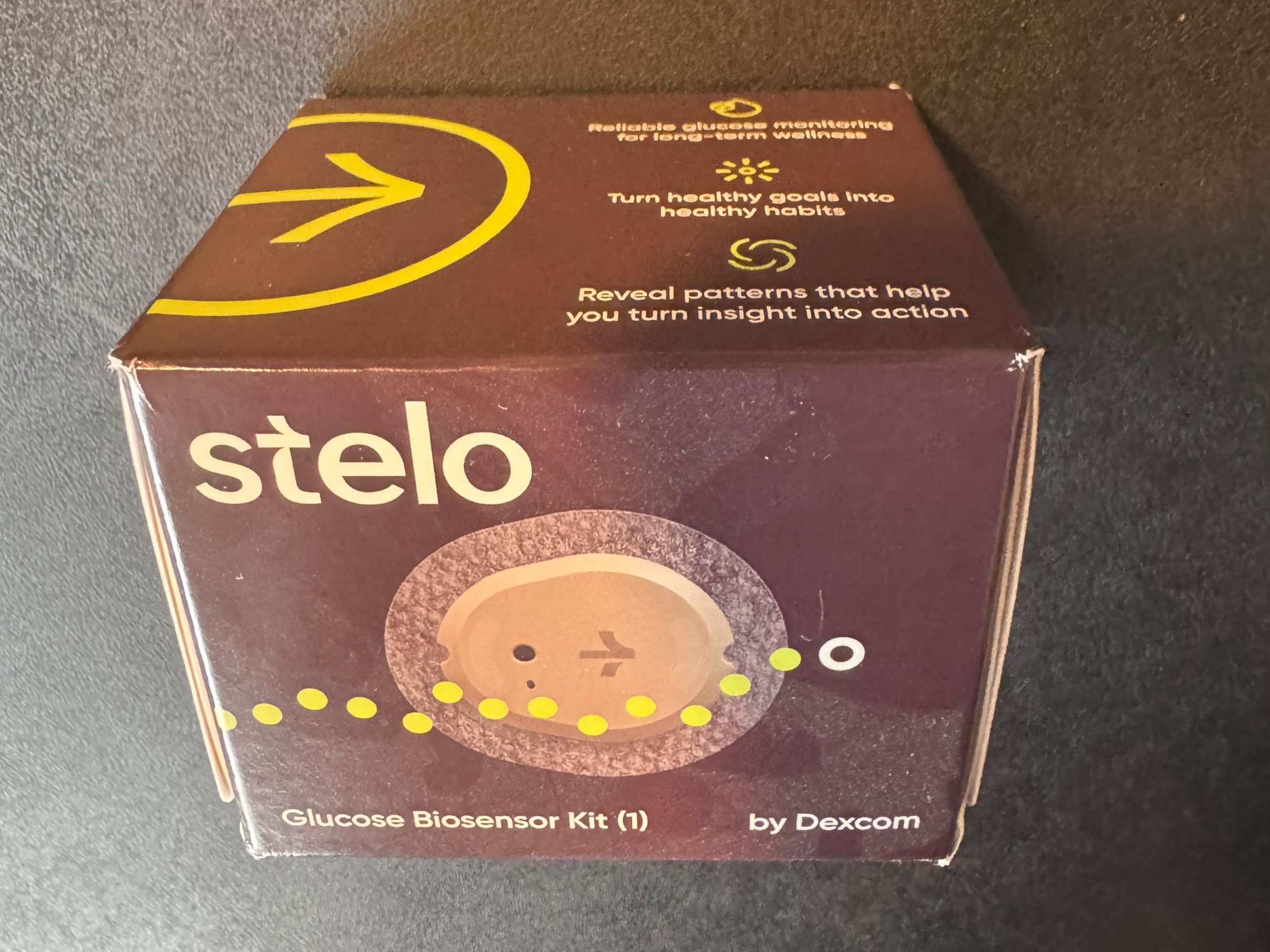
What is a continuous glucose monitor?
A CGM measures your blood sugar levels (blood glucose is blood sugar). In the case of the Dexcom Stelo, it measures your blood sugar levels every 5 minutes, and sends that information to an app on your phone every 15 minutes.
Blood sugar is a single data point, so it's important not to infer inaccurate information from the readings. However, using a CGM can help you understand what factors have the biggest impact on your blood sugar, which can have ramifications for your overall health.
Eating carbohydrates increases your blood sugar, and your pancreas produces the hormone insulin, which then reduces it. If your blood sugar is low, your liver can also release glycogen to raise your blood sugar again. So, your body generally keeps your blood sugar in the range of 70-140mg/dL for a nondiabetic. (I learned all this when I started managing my son's Type One Diabetes (T1D, where the body does not produce its own insulin, so it has to be given through a shot or a pump as part of manually controlling blood sugar levels), but the American Diabetes Association has a ton of great information.)
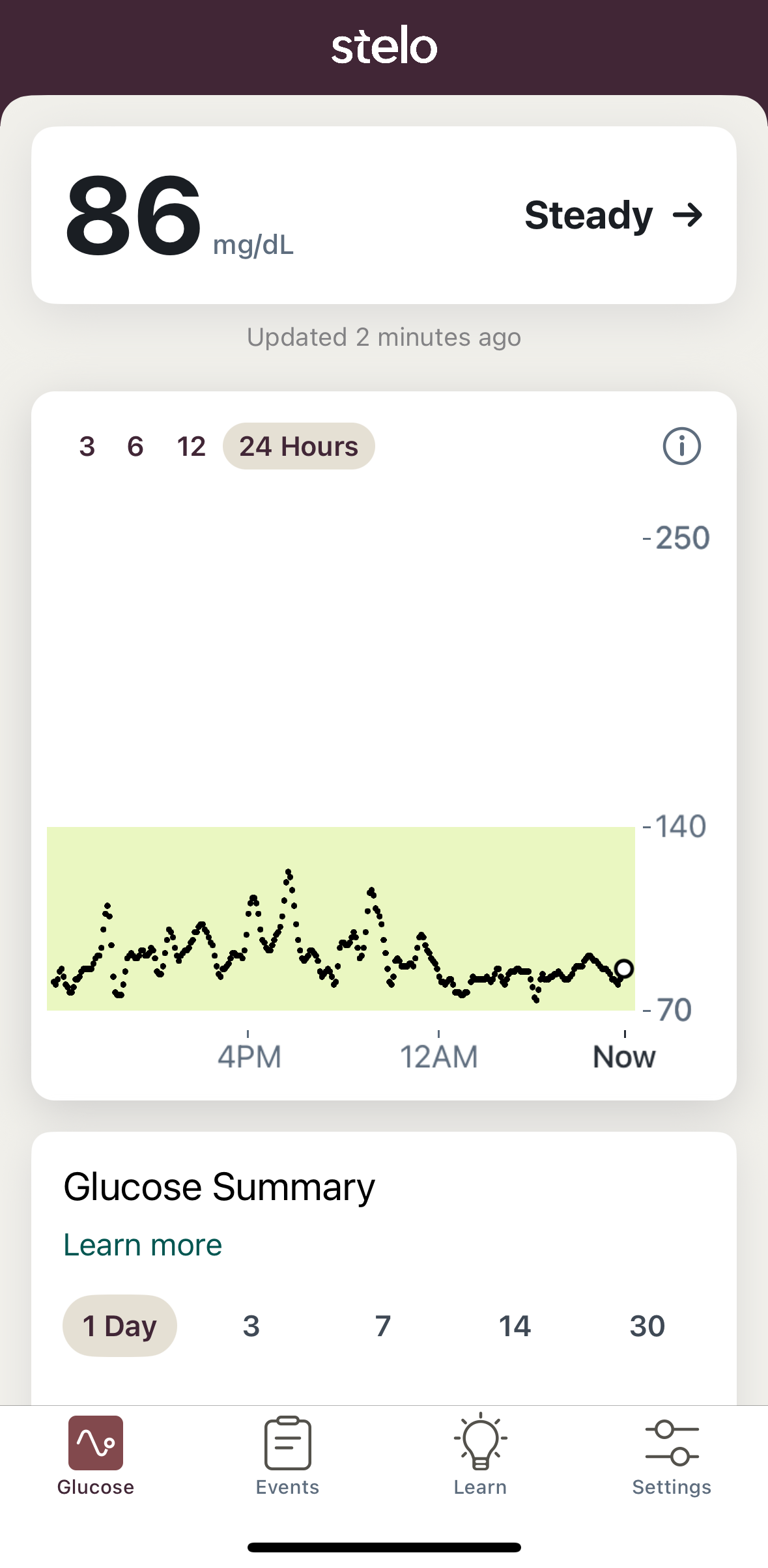
There's lots of other factors that can impact blood sugar, such as adrenaline (danger/excitement) or cortisol (stress), growth hormone for kids who are growing, or a woman's monthly cycle, to name a few.
You should research how to understand blood sugar and talk with your doctor to gain the greatest understanding of your own blood sugar levels.
Why I wanted to try a CGM
The main reason that I wanted to try a CGM is that my son has to wear one all of the time as part of managing his Type 1 Diabetes (T1D). I wanted him to see more other people using these devices to make him feel less singled out, as well as to better understand what the experience is like for him to use one. (My son currently uses the Dexcom G6 and is about to switch to the G7. These are different from the Stelo, because they are designed for diabetics and require a prescription, can integrate with some insulin pumps for automated dosing, and the associated apps have alerting capabilities for highs and lows.)
A secondary reason for me was understanding my own blood sugar levels and how they're impacted by what I eat.
My experience with the Dexcom Stelo
I ordered the 2-pack, with each device lasting 15 days. I tried the first one in September, and then waited and used the second one over Thanksgiving.
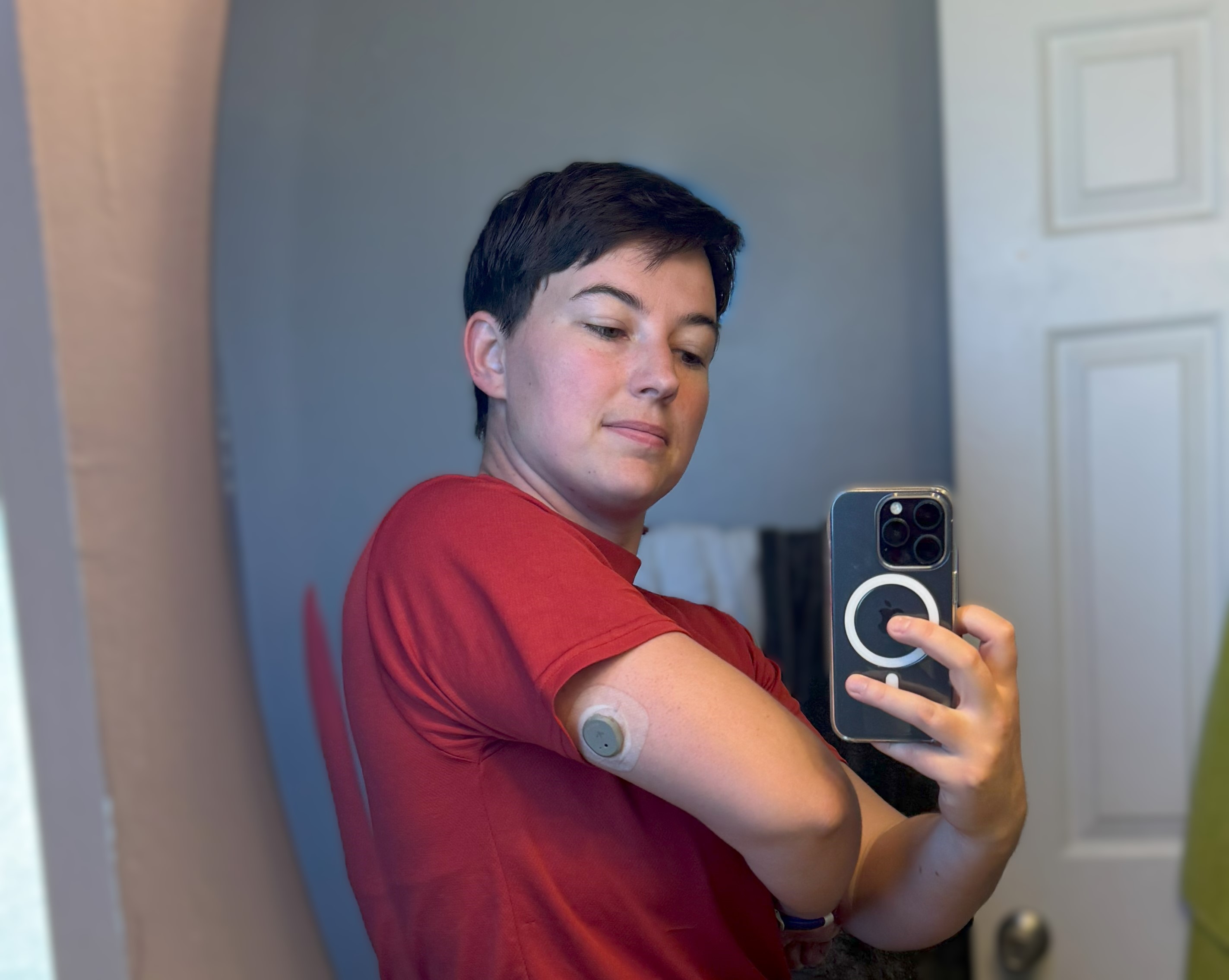
Did it hurt?
One of the biggest concerns people might have about wearing a CGM is pain or annoyance. For me, the device stung a little bit when the small sensor inserted into the skin, but that was relatively brief and minor. The first time, my arm was a little sore for about an hour, and the second time, I hardly felt it at all.
An interesting thing I did not expect was phantom pain in my opposite arm. There were a few times when I felt irritation or itching in the same location where the CGM was, but on the other arm. This helped me better understand why my son sometimes points to the wrong arm or leg when I ask where his CGM or insulin pump are.
The most painful part of my experience was actually removing the CGM, as it stuck to my arm really well. This makes sense, since they stay on for 15 days. I used some rubbing alcohol to help it come off (which is what we've found to work best for my son after trying several options), but it was still painful. However, like ripping off a bandage, that discomfort was pretty brief.
Working out
I was also concerned about working out while wearing the CGM. I went to the gym and Brazilian Jiu Jitsu classes while wearing it. When I got really sweaty at the gym, it did bother me a little a couple times, with minor itching and discomfort. It was under my gi at jiu jitsu, and I was worried about it being grabbed, but there was only once when it got pressed uncomfortably into my arm, and it really wasn't an issue. While the CGM did bother me a few times while working out, other times I didn't notice it at all in the gym. And the times it was annoying weren't bad enough to prevent me from working out.
It's also not an issue to swim, shower, or get the CGM wet. (If you're swimming for a while, you may notice that Bluetooth signals won't travel through water, so you won't get readings until you're out of the water.)
Social response
The CGM was visible when I was wearing short sleeve shirts, but most people didn't comment on it. I had a couple people ask about it, and I told them what it was and the conversation moved on.
There were a couple people with Type 2 Diabetes who asked me about it as they've thought about trying one, and I told them more about my experience.
For the most part, I forgot I was wearing it, and people didn't pay attention to it at all.
The edges of the adhesive did start to peel up a little bit the last few days and look a bit dirty, but it wasn't an issue.
I definitely still felt some anxiety around wearing the CGM in public. Despite largely not being commented on and the comments that I did receive being mostly positive, I found myself wondering if people would be rude or make false assumptions about me and my reasons for wearing one. There can be a mental load in being prepared to respond to other people's comments. But, as CGMs become more common, it's less and less likely people will question it.
Using the app
All around, the app was very intuitive, easy to use, and gave me interesting data.
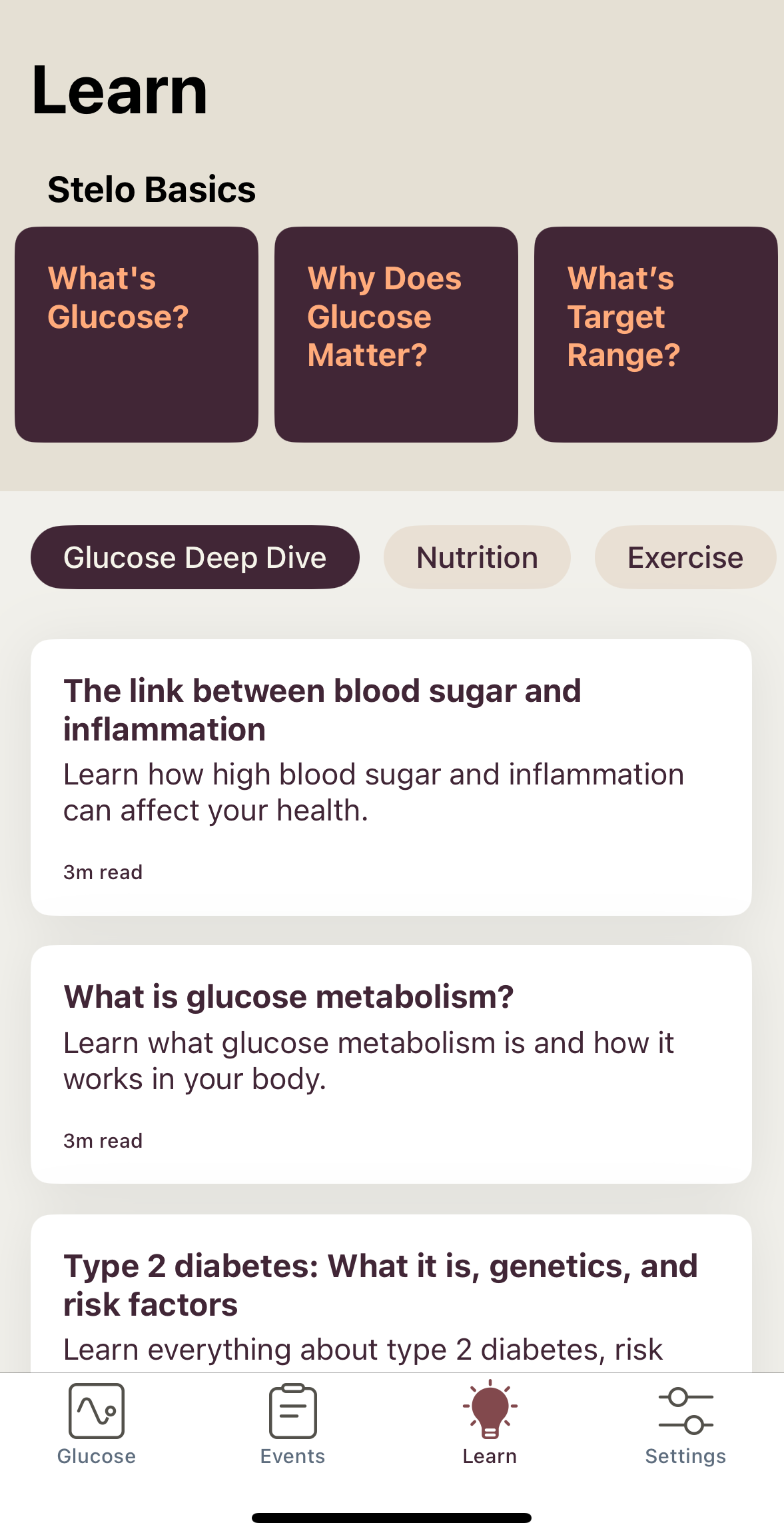
The app (on iPhone in my case) updated the readings every 15 minutes (and showed readings for every 5 minutes). There is some good educational content in the app, and the graph and the way values are shown is pretty intuitive.
If I ever closed the app, I would get a warning notification that I wouldn't get readings until the app was opened again, which was a bit annoying, since I tend to close apps. I would have preferred to have a widget on my home screen.
Dexcom advertises good accuracy with their CGMs, of being within 20% over 70mg/dL and within 20mg/dL below 70mg/dL. (See Dexcom's accuracy explanation here.) I wasn't expecting the data smoothing though, where sometimes a reading would change when the next readings came in to make a clearer trend. I couldn't find an explanation for data smoothing for the Stelo, but did find an article where Dexcom mentions it for their other CGMs. It makes sense that they smooth the data to avoid people coming to false conclusions about some natural variation in the measurements, but I would personally prefer to just have the actual raw data.
The Dexcom Stelo app also doesn't show any readings below 70mg/dL. To me, this was annoying, especially considering the advertised margin of error of either 20% or 20mg/dL. I'm sure their accuracy is actually better than what they advertise, because they need to guarantee staying within that margin. However, I would have liked to know what the actual readings were the several times it was below 70mg/dL for me (though it was never below that threshold for long).
Dexcom did have some alerts for glucose spikes, but it caught some and not others that I would have definitely considered spikes very similar to or even more signifiant than the ones that were caught. It was interesting to consider the reasons at the times when it did give notifications that my blood sugar had spiked though.
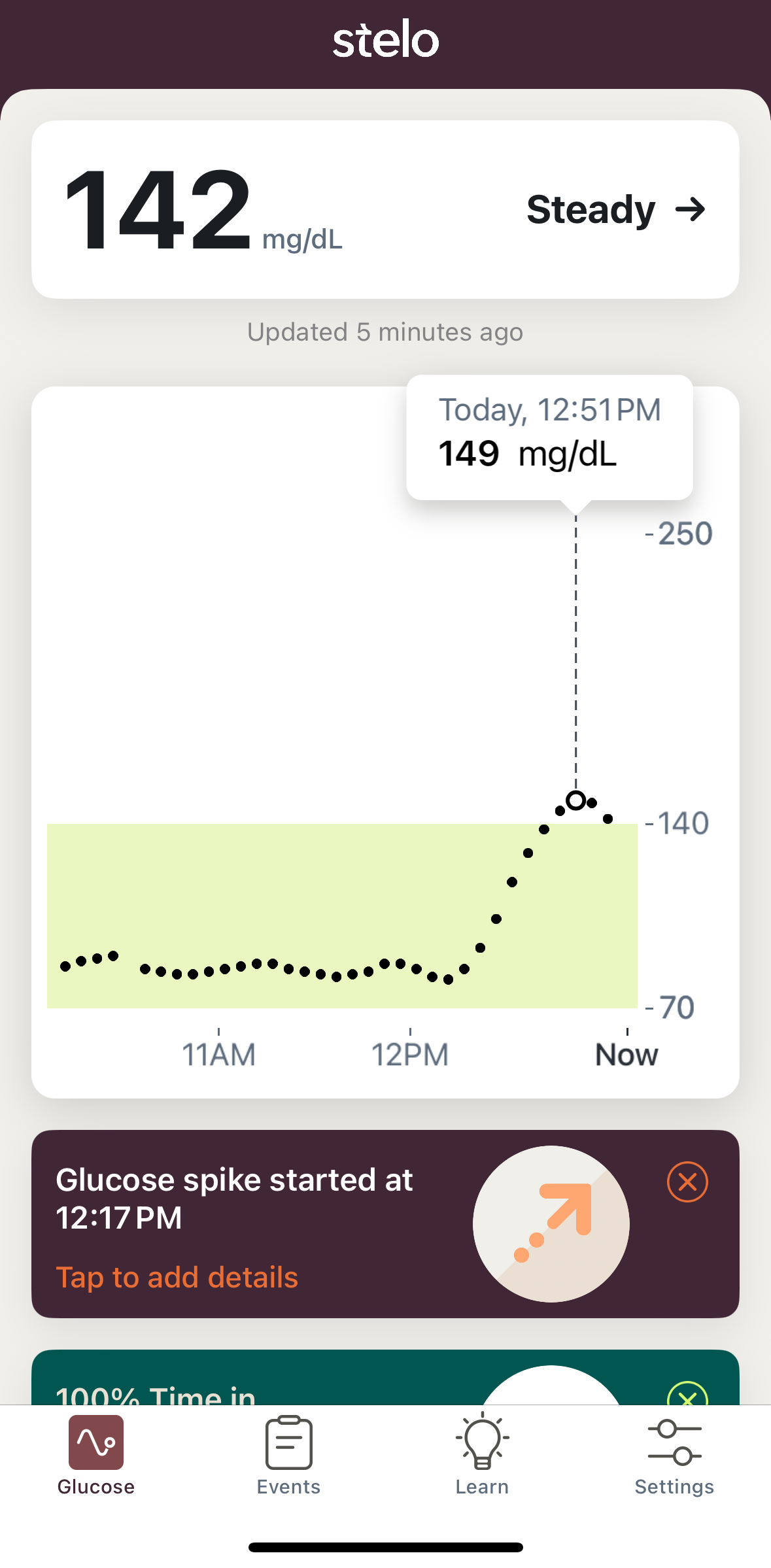
The app was very useful overall, and I learned a lot by using the Stelo for a few weeks.
What I learned about my blood sugar
For me, my blood sugar spiked the most when I went to restaurants, ate pizza, or had store-bought premade meals. Even eating some straight-up candy at home did not raise my blood sugar the same way eating at Cupbop once did. So, this makes a good argument for making more of my own food.
I also happened to have a lot more stress and less sleep for a few of the days while wearing the CGM, and my blood sugar was almost 10mg/dL higher on average those days. Seeing this physical response to stress was interesting, and makes me want to be more aware of my stress and more proactive in mitigating or addressing it.
I think it's worth noting that for some people, receiving new data about their blood sugar every 15 minutes could increase anxiety. I'm used to monitoring my son's blood sugar, so looking at mine every now and then when I don't need to address highs and lows wasn't too bad, but I wouldn't want to become obsessed with it.
I also found that I had a few large spikes during the middle of the night, hours after eating anything. I don't know if I had a stressful or exciting dream, some other hormones interacting, or what caused those spikes, but it's not worth over-analyzing things I can't easily control.
Moving forward
Overall, I'm glad that I tried the Dexcom Stelo CGM. I learned a lot about what the experience of wearing one is like for my son. And the fear of the unknown in trying something like this out was far greater than any minor frustrations I may have actually experienced.
There are other over-the-counter CGMs on the market now as well, such as the Abbott Lingo. I might try the Lingo sometime in the next year and see how my experience is different. Not having Diabetes myself, I don't have a reason to wear a CGM all the time, but I could see myself using one about once a year to see if I notice any changes.